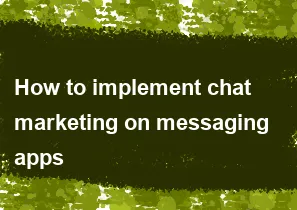How to implement chat marketing on messaging apps

Implementing chat marketing on messaging apps involves leveraging the capabilities of these platforms to engage with users, build relationships, and promote products or services. Here's a general guide to help you get started:
Choose the Right Messaging Apps:
- Identify the messaging apps that are most popular among your target audience. Examples include WhatsApp, Facebook Messenger, Telegram, and others.
Understand Your Audience:
- Define your target audience and understand their preferences. Tailor your messaging and content to resonate with them.
Create a Business Account:
- Set up a business account on the messaging app of your choice. Some platforms offer specific business accounts or features designed for marketing purposes.
Implement Chatbots:
- Develop or integrate a chatbot to automate responses and engage with users 24/7. Chatbots can handle frequently asked questions, provide information, and even guide users through the sales funnel.
Personalize Interactions:
- Use personalization techniques to make interactions more relevant. Address users by their names and tailor content based on their preferences and previous interactions.
Provide Value-Driven Content:
- Share valuable content, such as tips, recommendations, and exclusive offers, to keep users engaged and interested in your brand.
Promotions and Offers:
- Send promotional messages and exclusive offers to your subscribers. Consider using limited-time discounts or promotions to create a sense of urgency.
Use Multimedia:
- Incorporate multimedia elements like images, videos, and GIFs to make your messages more visually appealing and engaging.
Opt-In and Opt-Out Mechanism:
- Ensure that users have the option to opt in or opt out of receiving messages from your business. Comply with privacy regulations and respect user preferences.
Segment Your Audience:
- Segment your audience based on demographics, preferences, or behavior. This allows you to send targeted messages to specific groups, increasing the relevance of your communications.
Analytics and Monitoring:
- Use analytics tools provided by the messaging app or third-party solutions to track the performance of your chat marketing efforts. Monitor user engagement, click-through rates, and other relevant metrics.
Maintain a Conversational Tone:
- Keep the conversation casual and friendly. Avoid sounding too promotional or pushy, and encourage users to ask questions or provide feedback.
Compliance with Regulations:
- Be aware of and comply with data protection and privacy regulations, such as GDPR, to ensure the lawful use of user data for marketing purposes.
Integrate with Other Channels:
- Integrate your chat marketing efforts with other marketing channels to create a cohesive and omnichannel experience for your audience.
Remember, the success of your chat marketing strategy depends on continuous optimization and adaptation based on user feedback and analytics. Regularly assess your performance and adjust your approach accordingly.
-
Popular Post
- How to optimize for Google's About This Result feature for local businesses
- How to implement multi-language support in an Express.js application
- How to handle and optimize for changes in mobile search behavior
- How to handle CORS in a Node.js application
- How to use Vue.js with a UI framework (e.g., Vuetify, Element UI)
- How to configure Laravel Telescope for monitoring and profiling API requests
- How to create a command-line tool using the Commander.js library in Node.js
- How to implement code splitting in a React.js application
- How to use the AWS SDK for Node.js to interact with various AWS services
- How to use the Node.js Stream API for efficient data processing
- How to implement a cookie parser middleware in Node.js
- How to implement WebSockets for real-time communication in React
-
Latest Post
- How to implement a dynamic form with dynamic field styling based on user input in Next.js
- How to create a custom hook for handling user interactions with the browser's device motion in Next.js
- How to create a custom hook for handling user interactions with the browser's battery status in Next.js
- How to implement a dynamic form with dynamic field visibility based on user input in Next.js
- How to implement a dynamic form with real-time collaboration features in Next.js
- How to create a custom hook for handling user interactions with the browser's media devices in Next.js
- How to use the useSWRInfinite hook for paginating data with a custom loading indicator in Next.js
- How to create a custom hook for handling user interactions with the browser's network status in Next.js
- How to create a custom hook for handling user interactions with the browser's location in Next.js
- How to implement a dynamic form with multi-language support in Next.js
- How to create a custom hook for handling user interactions with the browser's ambient light sensor in Next.js
- How to use the useHover hook for creating interactive image zoom effects in Next.js